UAV Multisensor Observation of Floating Plastic Debris: Experimental Results from Lake Calore
Highlights
- Green and Red bands proved to be particularly effective for detecting plastics in freshwater environments.
- The proposed Plastic Detection Index (PDI) and Heterogeneity Plastic Index (HPI) enhanced the discrimination of plastics from water and vegetation.
- UAV-based multisensor systems represent a cost-effective solution for high-resolution monitoring of plastic pollution in inland waters.
- The methodology can be scaled to different aquatic environments and integrated into automated classification frameworks to support environmental monitoring programs.
Abstract
1. Introduction
2. Materials and Methods
2.1. Test Site and Experimental Setup
- Plastic Target (see Figure 1): A 2 × 2 m floating platform composed of heterogeneous plastic items, such as bottles, containers, and polystyrene (white or graphite), distributed over a supporting structure built from plastic tubing. The structure is anchored to the lake shores with four ropes to ensure stability during aerial data acquisitions. This plastic target is expected to mimic the behavior of floating aggregated plastic litter.
- Natural Target: An almost 5 m diameter compact aggregation of floating leaves and plant debris, naturally accumulated along the shore of the lake. The natural target is used to test the ability of UAV platforms to discriminate the plastic target from natural litter.
2.2. UAV Platforms and Sensors
2.3. Flight Planning and Data Acquisition
2.4. Photogrammetric Processing
- Image alignment and sparse point cloud generation;
- Dense point cloud reconstruction;
- Production of orthomosaics in RGB, multispectral, and thermal domains.
2.5. Optical Analysis
- The plastic target, situated in the central–northern region of the lake, which is marked by a red circle;
- A natural target, situated near the southern shore of the lake, which is marked by a blue circle.
2.6. Multispectral Pre-Processing
2.7. Thermal Pre-Processing
- Assess temperature contrasts between plastics, water, and natural debris;
- Evaluate intra-target variability among different plastic subtypes;
- Test the relative homogeneity of the natural reference target.
3. Results
3.1. Optical Results
3.2. Multispectral Results
3.3. Multispectral Indices
- Plastic Detection Index:
- 2.
- Heterogeneity Plastic Index
3.4. Thermal Results
4. Discussion
5. Conclusions
Author Contributions
Funding
Data Availability Statement
Acknowledgments
Conflicts of Interest
References
- Thiagarajan, C.; Devarajan, Y. The Urgent Challenge of Ocean Pollution: Impacts on Marine Biodiversity and Human Health. Reg. Stud. Mar. Sci. 2025, 81, 103995. [Google Scholar] [CrossRef]
- Simon, N.; Schulte, M.L. Stopping Global Plastic Pollution: The Case for an International Convention, 1st ed.; Ecology/Heinrich Böll Foundation: Berlin, Germany, 2017; ISBN 978-3-86928-159-9. [Google Scholar]
- Gall, S.C.; Thompson, R.C. The Impact of Debris on Marine Life. Mar. Pollut. Bull. 2015, 92, 170–179. [Google Scholar] [CrossRef]
- Beaumont, N.J.; Aanesen, M.; Austen, M.C.; Börger, T.; Clark, J.R.; Cole, M.; Hooper, T.; Lindeque, P.K.; Pascoe, C.; Wyles, K.J. Global Ecological, Social and Economic Impacts of Marine Plastic. Mar. Pollut. Bull. 2019, 142, 189–195. [Google Scholar] [CrossRef]
- Lau, W.W.Y.; Shiran, Y.; Bailey, R.M.; Cook, E.; Stuchtey, M.R.; Koskella, J.; Velis, C.A.; Godfrey, L.; Boucher, J.; Murphy, M.B.; et al. Evaluating Scenarios toward Zero Plastic Pollution. Science 2020, 369, 1455–1461. [Google Scholar] [CrossRef]
- Li, W.C.; Tse, H.F.; Fok, L. Plastic Waste in the Marine Environment: A Review of Sources, Occurrence and Effects. Sci. Total Environ. 2016, 566–567, 333–349. [Google Scholar] [CrossRef] [PubMed]
- Oluniyi Solomon, O.; Palanisami, T. Microplastics in the Marine Environment: Current Status, Assessment Methodologies, Impacts and Solutions. J. Pollut. Eff. Cont. 2016, 4, 1000161. [Google Scholar] [CrossRef]
- Sheppard, C.R.C. World Seas: An Environmental Evaluation, 2nd ed.; Academic Press, an Imprint of Elsevier: London, UK, 2019; ISBN 978-0-12-805204-4. [Google Scholar]
- Toussaint, B.; Raffael, B.; Angers-Loustau, A.; Gilliland, D.; Kestens, V.; Petrillo, M.; Rio-Echevarria, I.M.; Van Den Eede, G. Review of Micro- and Nanoplastic Contamination in the Food Chain. Food Addit. Contam. Part A 2019, 36, 639–673. [Google Scholar] [CrossRef]
- Prata, J.C.; Da Costa, J.P.; Lopes, I.; Duarte, A.C.; Rocha-Santos, T. Environmental Exposure to Microplastics: An Overview on Possible Human Health Effects. Sci. Total Environ. 2020, 702, 134455. [Google Scholar] [CrossRef]
- Rhodes, C.J. Solving the Plastic Problem: From Cradle to Grave, to Reincarnation. Sci. Prog. 2019, 102, 218–248. [Google Scholar] [CrossRef]
- Gallo, F.; Fossi, C.; Weber, R.; Santillo, D.; Sousa, J.; Ingram, I.; Nadal, A.; Romano, D. Marine Litter Plastics and Microplastics and Their Toxic Chemicals Components: The Need for Urgent Preventive Measures. Environ. Sci. Eur. 2018, 30, 13. [Google Scholar] [CrossRef] [PubMed]
- Salgado-Hernanz, P.M.; Bauzà, J.; Alomar, C.; Compa, M.; Romero, L.; Deudero, S. Assessment of Marine Litter through Remote Sensing: Recent Approaches and Future Goals. Mar. Pollut. Bull. 2021, 168, 112347. [Google Scholar] [CrossRef] [PubMed]
- Themistocleous, K.; Papoutsa, C.; Michaelides, S.; Hadjimitsis, D. Investigating Detection of Floating Plastic Litter from Space Using Sentinel-2 Imagery. Remote Sens. 2020, 12, 2648. [Google Scholar] [CrossRef]
- Topouzelis, K.; Papageorgiou, D.; Suaria, G.; Aliani, S. Floating Marine Litter Detection Algorithms and Techniques Using Optical Remote Sensing Data: A Review. Mar. Pollut. Bull. 2021, 170, 112675. [Google Scholar] [CrossRef]
- Duarte, M.M.; Azevedo, L. Erratum to “Automatic Detection and Identification of Floating Marine Debris Using Multispectral Satellite Imagery”. IEEE Trans. Geosci. Remote Sens. 2023, 61, 2002315. [Google Scholar] [CrossRef]
- Basu, B.; Sannigrahi, S.; Sarkar Basu, A.; Pilla, F. Development of Novel Classification Algorithms for Detection of Floating Plastic Debris in Coastal Waterbodies Using Multispectral Sentinel-2 Remote Sensing Imagery. Remote Sens. 2021, 13, 1598. [Google Scholar] [CrossRef]
- De Giglio, M.; Dubbini, M.; Cortesi, I.; Maraviglia, M.; Parisi, E.I.; Tucci, G. Plastics Waste Identification in River Ecosystems by Multispectral Proximal Sensing: A Preliminary Methodology Study. Water Environ. J. 2021, 35, 569–579. [Google Scholar] [CrossRef]
- Vidal, M.; Gowen, A.; Amigo, J.M. NIR Hyperspectral Imaging for Plastics Classification. NIR News 2012, 23, 13–15. [Google Scholar] [CrossRef]
- Kremezi, M.; Kristollari, V.; Karathanassi, V.; Topouzelis, K.; Kolokoussis, P.; Taggio, N.; Aiello, A.; Ceriola, G.; Barbone, E.; Corradi, P. Pansharpening PRISMA Data for Marine Plastic Litter Detection Using Plastic Indexes. IEEE Access 2021, 9, 61955–61971. [Google Scholar] [CrossRef]
- Tasseron, P.; Van Emmerik, T.; Peller, J.; Schreyers, L.; Biermann, L. Advancing Floating Macroplastic Detection from Space Using Experimental Hyperspectral Imagery. Remote Sens. 2021, 13, 2335. [Google Scholar] [CrossRef]
- Goddijn-Murphy, L.; Williamson, B.J.; McIlvenny, J.; Corradi, P. Using a UAV Thermal Infrared Camera for Monitoring Floating Marine Plastic Litter. Remote Sens. 2022, 14, 3179. [Google Scholar] [CrossRef]
- Garaba, S.P.; Acuña-Ruz, T.; Mattar, C.B. Hyperspectral Longwave Infrared Reflectance Spectra of Naturally Dried Algae, Anthropogenic Plastics, Sands and Shells. Earth Syst. Sci. Data 2020, 12, 2665–2678. [Google Scholar] [CrossRef]
- Palombi, L.; Raimondi, V. Experimental Tests for Fluorescence LIDAR Remote Sensing of Submerged Plastic Marine Litter. Remote Sens. 2022, 14, 5914. [Google Scholar] [CrossRef]
- Spizzichino, V.; Caneve, L.; Colao, F.; Ruggiero, L. Characterization and Discrimination of Plastic Materials Using Laser-Induced Fluorescence. Appl. Spectrosc. 2016, 70, 1001–1008. [Google Scholar] [CrossRef] [PubMed]
- Piruska, A.; Nikcevic, I.; Lee, S.H.; Ahn, C.; Heineman, W.R.; Limbach, P.A.; Seliskar, C.J. The Autofluorescence of Plastic Materials and Chips Measured under Laser Irradiation. Lab Chip 2005, 5, 1348. [Google Scholar] [CrossRef] [PubMed]
- Kalogirou, E.; Christofi, K.; Makri, D.; Iqbal, M.A.; La Pegna, V.; Tzouvaras, M.; Mettas, C.; Hadjimitsis, D. Oil Spill Detection Using Convolutional Neural Networks and Sentinel-1 SAR Imagery. Int. Arch. Photogramm. Remote Sens. Spatial Inf. Sci. 2025, 48, 757–764. [Google Scholar] [CrossRef]
- Meng, T.; Nunziata, F.; Yang, X.; Buono, A.; Chen, K.-S.; Migliaccio, M. Scattering Model-Based Oil-Slick-Related Parameters Estimation from Radar Remote Sensing: Feasibility and Simulation Results. IEEE Trans. Geosci. Remote Sens. 2024, 62, 4203412. [Google Scholar] [CrossRef]
- Jamal, S.; Sun, G.; Li, Y.; Khan, A.Q.; Zhang, Y.; Verlanti, A.; Nunziata, F. CWCM-Net: A Novel Feature Fusion Method for Oil Spill Detection Using Single- and Quad-Polarization SAR Data. IEEE J. Sel. Top. Appl. Earth Obs. Remote Sens. 2025, 18, 19115–19128. [Google Scholar] [CrossRef]
- Savastano, S.; Cester, I.; Perpinya, M.; Romero, L. A First Approach to the Automatic Detection of Marine Litter in SAR Images Using Artificial Intelligence. In Proceedings of the 2021 IEEE International Geoscience and Remote Sensing Symposium IGARSS, Brussels, Belgium, 11–16 July 2021; IEEE: Brussels, Belgium, 2021; pp. 8704–8707. [Google Scholar]
- Davaasuren, N.; Marino, A.; Boardman, C.; Alparone, M.; Nunziata, F.; Ackermann, N.; Hajnsek, I. Detecting Microplastics Pollution in World Oceans Using Sar Remote Sensing. In Proceedings of the IGARSS 2018—2018 IEEE International Geoscience and Remote Sensing Symposium, Valencia, Spain, 22–27 July 2018; IEEE: Valencia, Spain, 2018; pp. 938–941. [Google Scholar]
- Simpson, M.D.; Marino, A.; De Maagt, P.; Gandini, E.; Hunter, P.; Spyrakos, E.; Tyler, A.; Telfer, T. Monitoring of Plastic Islands in River Environment Using Sentinel-1 SAR Data. Remote Sens. 2022, 14, 4473. [Google Scholar] [CrossRef]
- Chen, Z.; Li, F. Mapping Plastic-Mulched Farmland with C-Band Full Polarization SAR Remote Sensing Data. Remote Sens. 2017, 9, 1264. [Google Scholar] [CrossRef]
- Da Costa, T.S.; Felício, J.M.; Matos, S.A.; Costa, J.R.; Fernandes, C.A.; Fonseca, N.J.G. Monitoring Plastic Accumulations in a River Environment Using Machine Learning on Sentinel-1 SAR Data. In Proceedings of the 2025 19th European Conference on Antennas and Propagation (EuCAP), Stockholm, Sweden, 30 March–4 April 2025; IEEE: Stockholm, Sweden, 2025; pp. 1–5. [Google Scholar]
- Garaba, S.P.; Aitken, J.; Slat, B.; Dierssen, H.M.; Lebreton, L.; Zielinski, O.; Reisser, J. Sensing Ocean Plastics with an Airborne Hyperspectral Shortwave Infrared Imager. Environ. Sci. Technol. 2018, 52, 11699–11707. [Google Scholar] [CrossRef]
- Jakovljevic, G.; Govedarica, M.; Alvarez-Taboada, F. A Deep Learning Model for Automatic Plastic Mapping Using Unmanned Aerial Vehicle (UAV) Data. Remote Sens. 2020, 12, 1515. [Google Scholar] [CrossRef]
- Maharjan, N.; Miyazaki, H.; Pati, B.M.; Dailey, M.N.; Shrestha, S.; Nakamura, T. Detection of River Plastic Using UAV Sensor Data and Deep Learning. Remote Sens. 2022, 14, 3049. [Google Scholar] [CrossRef]
- Taddia, Y.; Corbau, C.; Buoninsegni, J.; Simeoni, U.; Pellegrinelli, A. UAV Approach for Detecting Plastic Marine Debris on the Beach: A Case Study in the Po River Delta (Italy). Drones 2021, 5, 140. [Google Scholar] [CrossRef]
- Geraeds, M.; Van Emmerik, T.; De Vries, R.; Bin Ab Razak, M.S. Riverine Plastic Litter Monitoring Using Unmanned Aerial Vehicles (UAVs). Remote Sens. 2019, 11, 2045. [Google Scholar] [CrossRef]
- Denih, A.; Matsumoto, T.; Rachman, I.; Putra, G.R.; Anggraeni, I.; Kurnia, E.; Suhendar, E.; Simamora, A.M. Identification of Plastic Waste with Unmanned Aerial Vehicle (UAV) Using Deep Learning and Internet of Things (IoT). J. Hazard. Mater. Adv. 2025, 18, 100622. [Google Scholar] [CrossRef]
- Zhou, S.; Kaufmann, H.; Bohn, N.; Bochow, M.; Kuester, T.; Segl, K. Identifying Distinct Plastics in Hyperspectral Experimental Lab-, Aircraft-, and Satellite Data Using Machine/Deep Learning Methods Trained with Synthetically Mixed Spectral Data. Remote Sens. Environ. 2022, 281, 113263. [Google Scholar] [CrossRef]
- Topouzelis, K.; Papakonstantinou, A.; Garaba, S.P. Detection of Floating Plastics from Satellite and Unmanned Aerial Systems (Plastic Litter Project 2018). Int. J. Appl. Earth Obs. Geoinf. 2019, 79, 175–183. [Google Scholar] [CrossRef]
- Goddijn-Murphy, L.; Martínez-Vicente, V.; Dierssen, H.M.; Raimondi, V.; Gandini, E.; Foster, R.; Chirayath, V. Emerging Technologies for Remote Sensing of Floating and Submerged Plastic Litter. Remote Sens. 2024, 16, 1770. [Google Scholar] [CrossRef]
- Rettig, R.; Becker, F.; Berghoff, A.; Binkele, T.; Butter, W.M.; Floehr, T.; Kumm, M.; Leluschko, C.; Littau, F.; Reinders, E.; et al. Multi-Resolution Remote Sensing Dataset for the Detection of Anthropogenic Litter: A Multi-Platform and Multi-Sensor Approach. Data 2025, 10, 113. [Google Scholar] [CrossRef]
- Nunziata, F.; Serafino, F.; Vicari, A.; Migliaccio, M.; Bianco, A.; Verlanti, A.; Di Michele, L.; Cotroneo, Y.; Aulicino, G.; Famiglietti, N.A.; et al. Multi-Layer Approach to Detect and Analyze Coastal Aggregation of Macro-Plastic Litter. In Proceedings of the 2024 IEEE International Workshop on Metrology for the Sea; Learning to Measure Sea Health Parameters (MetroSea), Portorose, Slovenia, 14–16 October 2024; IEEE: Portorose, Slovenia, 2024; pp. 364–368. [Google Scholar]
- Simpson, M.D.; Marino, A.; De Maagt, P.; Gandini, E.; De Fockert, A.; Hunter, P.; Spyrakos, E.; Telfer, T.; Tyler, A. Investigating the Backscatter of Marine Plastic Litter Using a C- and X-Band Ground Radar, during a Measurement Campaign in Deltares. Remote Sens. 2023, 15, 1654. [Google Scholar] [CrossRef]
- Felício, J.M.; Costa, T.S.; Vala, M.; Leonor, N.; Costa, J.R.; Marques, P.; Moreira, A.A.; Caldeirinha, R.F.S.; Matos, S.A.; Fernandes, C.A.; et al. Feasibility of Radar-Based Detection of Floating Macroplastics at Microwave Frequencies. IEEE Trans. Antennas Propagat. 2024, 72, 2766–2779. [Google Scholar] [CrossRef]
- Alboody, A.; Vandenbroucke, N.; Porebski, A.; Sawan, R.; Viudes, F.; Doyen, P.; Amara, R. A New Remote Hyperspectral Imaging System Embedded on an Unmanned Aquatic Drone for the Detection and Identification of Floating Plastic Litter Using Machine Learning. Remote Sens. 2023, 15, 3455. [Google Scholar] [CrossRef]
- Moshtaghi, M.; Knaeps, E.; Sterckx, S.; Garaba, S.; Meire, D. Spectral Reflectance of Marine Macroplastics in the VNIR and SWIR Measured in a Controlled Environment. Sci. Rep. 2021, 11, 5436. [Google Scholar] [CrossRef] [PubMed]
- Biermann, L.; Clewley, D.; Martinez-Vicente, V.; Topouzelis, K. Finding Plastic Patches in Coastal Waters Using Optical Satellite Data. Sci. Rep. 2020, 10, 5364. [Google Scholar] [CrossRef] [PubMed]
- Guo, X.; Li, P. Mapping Plastic Materials in an Urban Area: Development of the Normalized Difference Plastic Index Using WorldView-3 Superspectral Data. ISPRS J. Photogramm. Remote Sens. 2020, 169, 214–226. [Google Scholar] [CrossRef]
- Guffogg, J.; Soto-Berelov, M.; Bellman, C.; Jones, S.; Skidmore, A. Beached Plastic Debris Index; a Modern Index for Detecting Plastics on Beaches. Mar. Pollut. Bull. 2024, 209, 117124. [Google Scholar] [CrossRef]
- Nunziata, F.; Famiglietti, N.A.; Vicari, A.; Memmolo, A.; Migliazza, R.; Verlanti, A.; Buono, A.; Migliaccio, M. An Experimental Campaign to Observe Floating Plastic Using a Multi-Sensor Strategy. In Proceedings of the OCEANS 2025 Brest, Brest, France, 16–19 June 2025; IEEE: Brest, France, 2025; pp. 1–4. [Google Scholar]
- INGV RING Working Group. Rete Integrata Nazionale GPS (RING); [Data set]; Istituto Nazionale di Geofisica e Vulcanologia (INGV): Roma, Italy, 2016. [Google Scholar] [CrossRef]
- Famiglietti, N.A.; Cecere, G.; Grasso, C.; Memmolo, A.; Vicari, A. A Test on the Potential of a Low Cost Unmanned Aerial Vehicle RTK/PPK Solution for Precision Positioning. Sensors 2021, 21, 3882. [Google Scholar] [CrossRef]
- Hu, C. Remote Detection of Marine Debris Using Satellite Observations in the Visible and near Infrared Spectral Range: Challenges and Potentials. Remote Sens. Environ. 2021, 259, 112414. [Google Scholar] [CrossRef]
- Holt, Z.K.; Khan, S.D.; Rodrigues, D.F. Hyperspectral Remote Sensing as an Environmental Plastic Pollution Detection Approach to Determine Occurrence of Microplastics in Diverse Environments. Environ. Pollut. 2025, 377, 126426. [Google Scholar] [CrossRef] [PubMed]
- Corbari, L.; Capodici, F.; Ciraolo, G.; Topouzelis, K. Marine Plastic Detection Using PRISMA Hyperspectral Satellite Imagery in a Controlled Environment. Int. J. Remote Sens. 2023, 44, 6845–6859. [Google Scholar] [CrossRef]
- Deng, R.; He, Y.; Qin, Y.; Chen, Q.; Chen, L. Measuring Pure Water Absorption Coefficient in the Near-Infrared Spectrum (900–2500 Nm). Natl. Remote Sens. Bull. 2012, 16, 192–206. [Google Scholar] [CrossRef]
- Bi, S.; Li, Y.; Wang, Q.; Lyu, H.; Liu, G.; Zheng, Z.; Du, C.; Mu, M.; Xu, J.; Lei, S.; et al. Inland Water Atmospheric Correction Based on Turbidity Classification Using OLCI and SLSTR Synergistic Observations. Remote Sens. 2018, 10, 1002. [Google Scholar] [CrossRef]
- Cui, M.; Sun, Y.; Huang, C.; Li, M. Water Turbidity Retrieval Based on UAV Hyperspectral Remote Sensing. Water 2022, 14, 128. [Google Scholar] [CrossRef]
- Röttgers, R.; McKee, D.; Utschig, C. Temperature and Salinity Correction Coefficients for Light Absorption by Water in the Visible to Infrared Spectral Region. Opt. Express 2014, 22, 25093–25108. [Google Scholar] [CrossRef]
- Wang, S.; Zhao, W.; Sun, D.; Li, Z.; Shen, C.; Bu, X.; Zhang, H. Unveiling Reflectance Spectral Characteristics of Floating Plastics across Varying Coverages: Insights and Retrieval Model. Opt. Express 2024, 32, 22078–22094. [Google Scholar] [CrossRef]
- Knaeps, E.; Sterckx, S.; Strackx, G.; Mijnendonckx, J.; Moshtaghi, M.; Garaba, S.P.; Meire, D. Hyperspectral-Reflectance Dataset of Dry, Wet and Submerged Marine Litter. Earth Syst. Sci. Data 2021, 13, 713–730. [Google Scholar] [CrossRef]
- Hedley, J.D.; Harborne, A.R.; Mumby, P.J. Technical Note: Simple and Robust Removal of Sun Glint for Mapping Shallow-water Benthos. Int. J. Remote Sens. 2005, 26, 2107–2112. [Google Scholar] [CrossRef]
- Stow, D.; Nichol, C.J.; Wade, T.; Assmann, J.J.; Simpson, G.; Helfter, C. Illumination Geometry and Flying Height Influence Surface Reflectance and NDVI Derived from Multispectral UAS Imagery. Drones 2019, 3, 55. [Google Scholar] [CrossRef]
- Kutser, T.; Vahtmäe, E.; Praks, J. A Sun Glint Correction Method for Hyperspectral Imagery Containing Areas with Non-Negligible Water Leaving NIR Signal. Remote Sens. Environ. 2009, 113, 2267–2274. [Google Scholar] [CrossRef]
- Sun, Y.; Qin, Q.; Ren, H.; Zhang, T.; Chen, S. Red-Edge Band Vegetation Indices for Leaf Area Index Estimation from Sentinel-2/MSI Imagery. IEEE Trans. Geosci. Remote Sens. 2020, 58, 826–840. [Google Scholar] [CrossRef]
- Widjaja Putra, B.T.; Soni, P. Evaluating NIR-Red and NIR-Red Edge External Filters with Digital Cameras for Assessing Vegetation Indices under Different Illumination. Infrared Phys. Technol. 2017, 81, 148–156. [Google Scholar] [CrossRef]
- Zeng, Y.; Hao, D.; Badgley, G.; Damm, A.; Rascher, U.; Ryu, Y.; Johnson, J.; Krieger, V.; Wu, S.; Qiu, H.; et al. Estimating Near-Infrared Reflectance of Vegetation from Hyperspectral Data. Remote Sens. Environ. 2021, 267, 112723. [Google Scholar] [CrossRef]


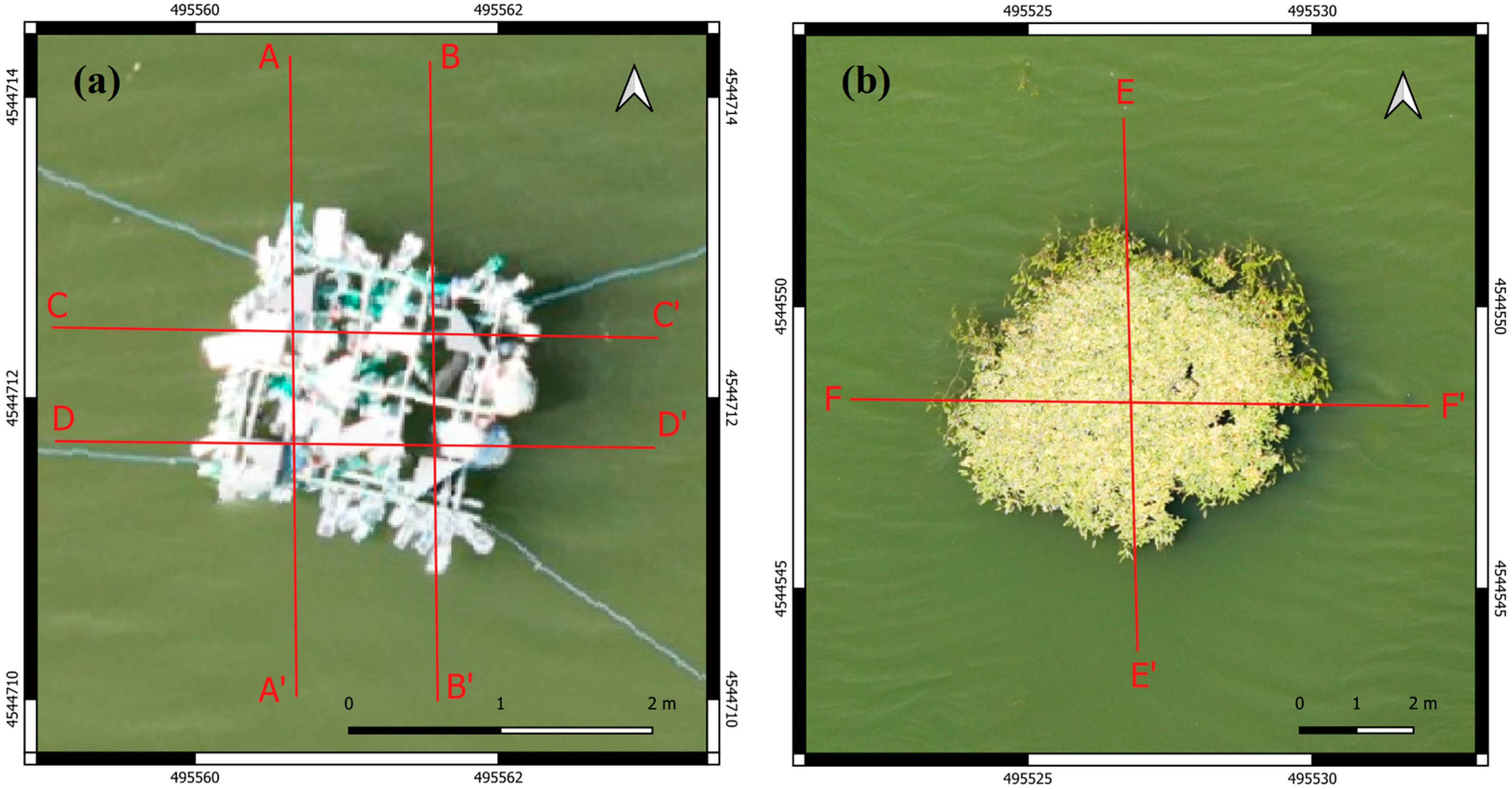

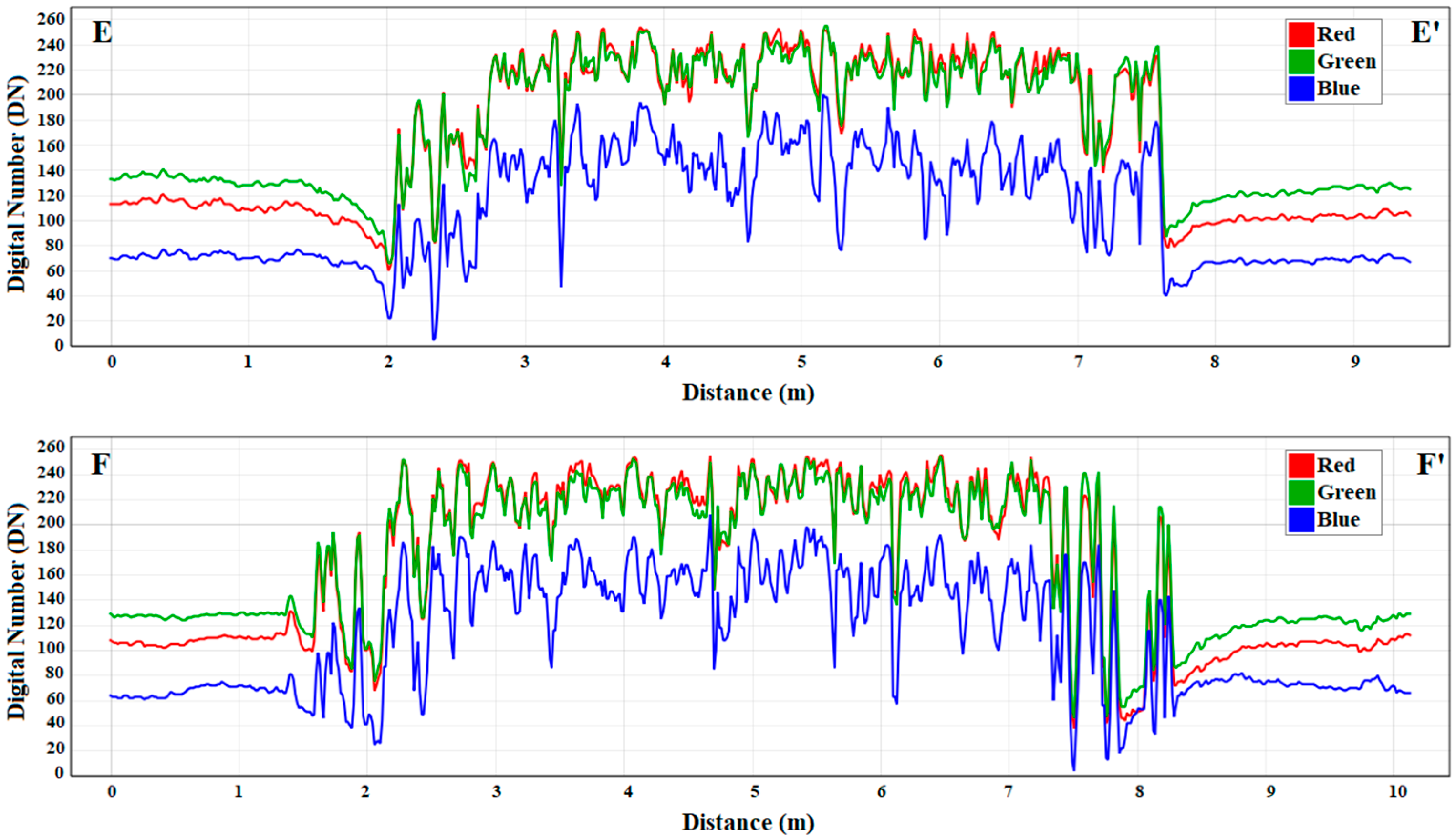

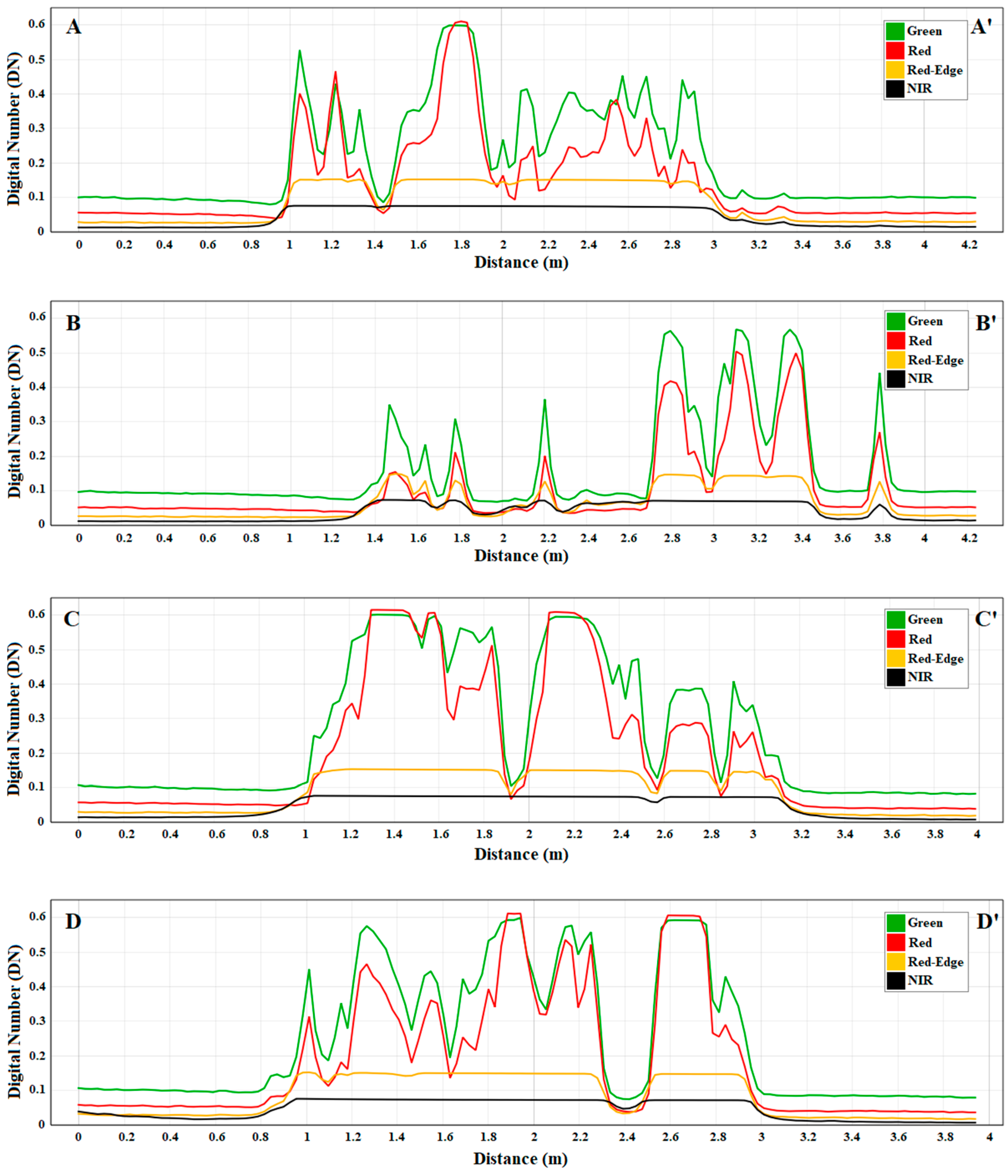

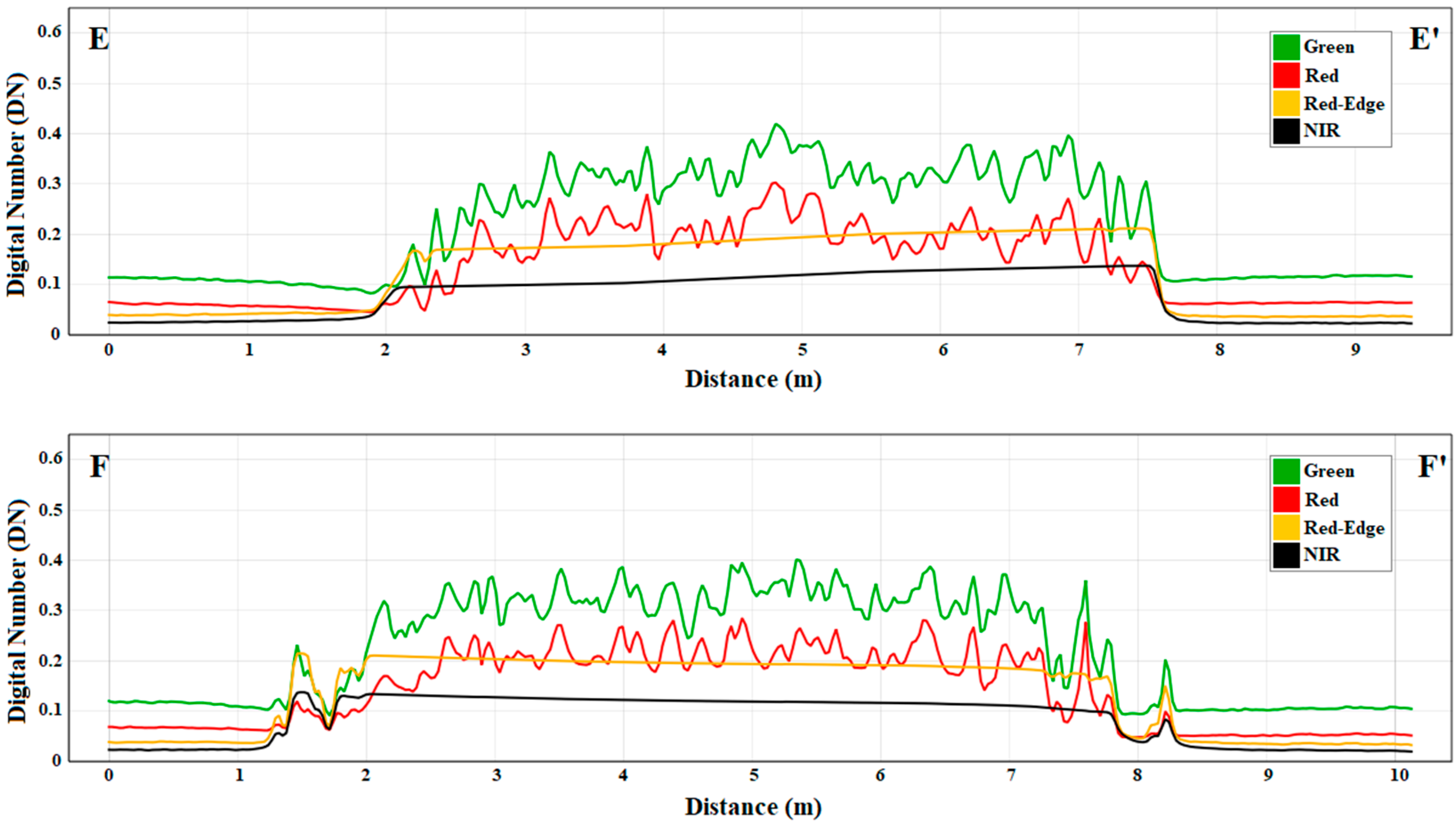
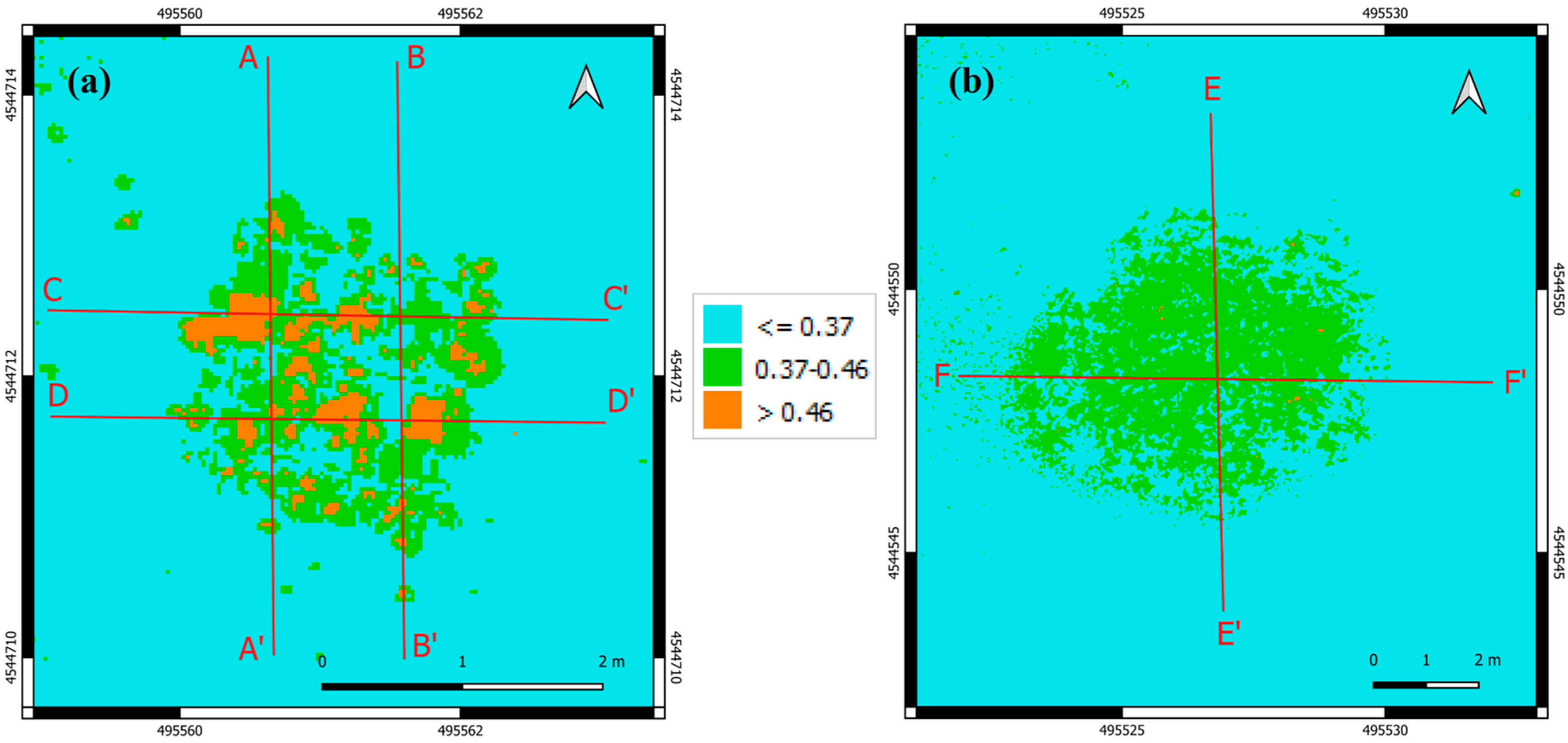

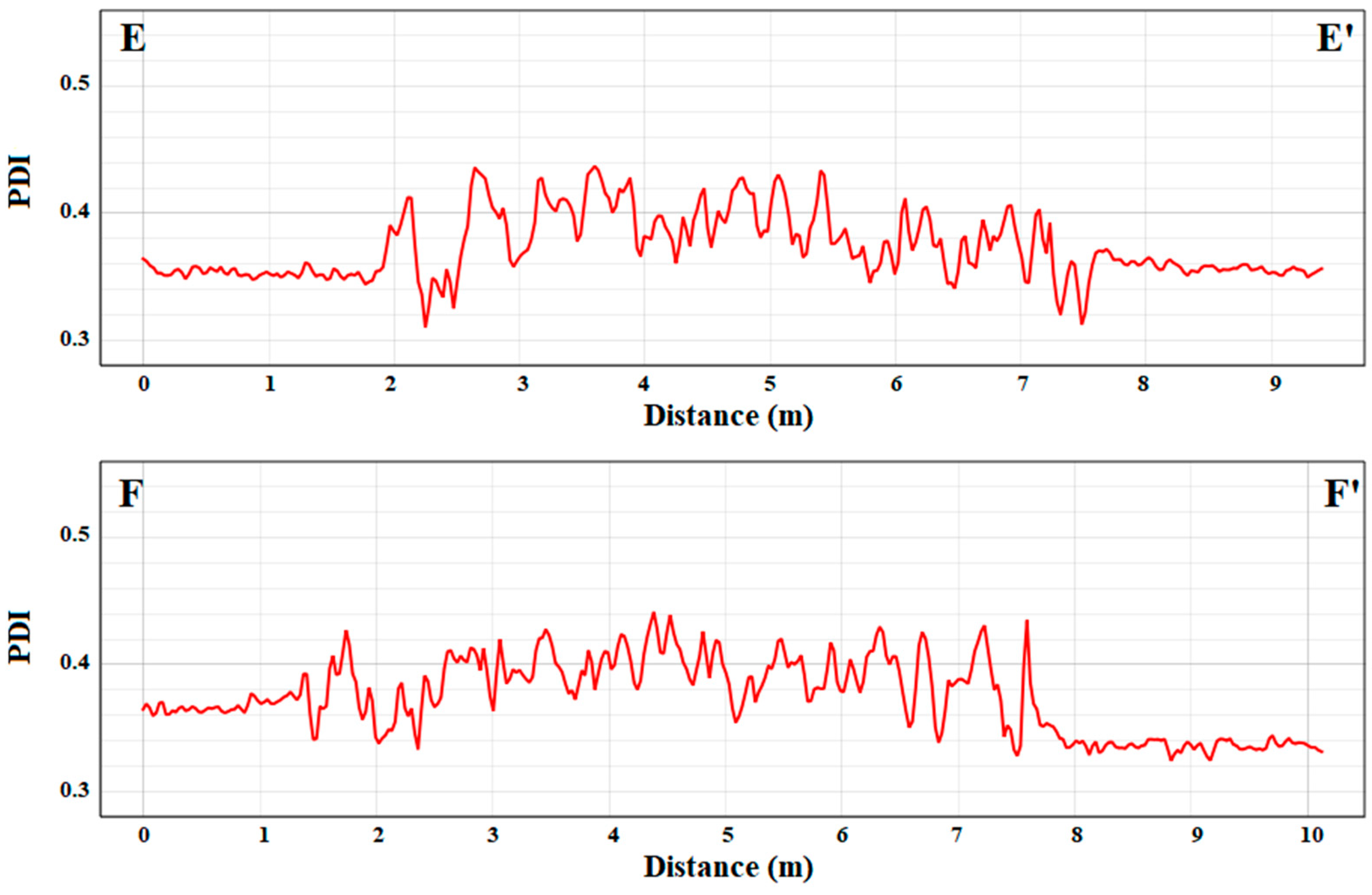


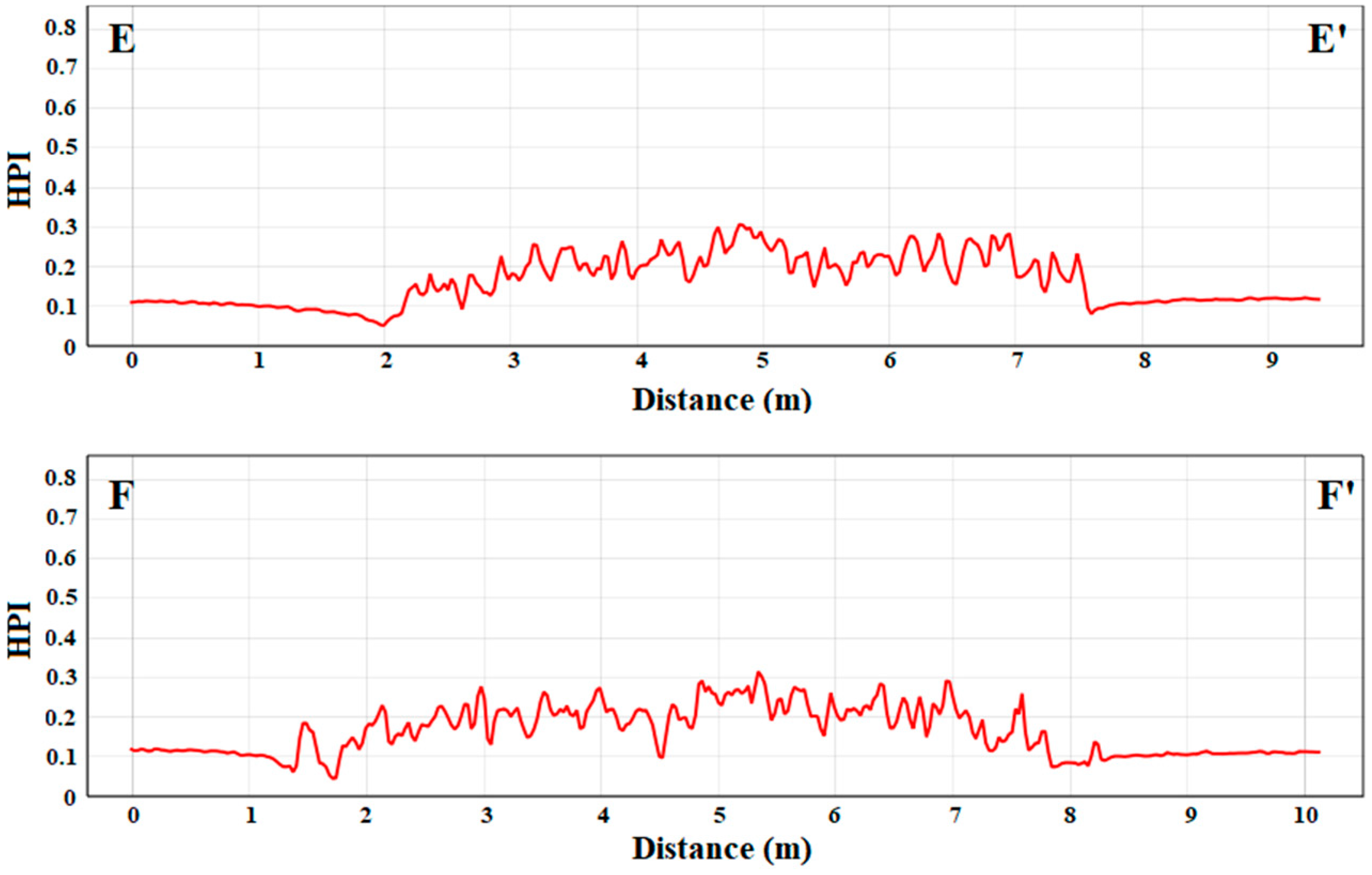
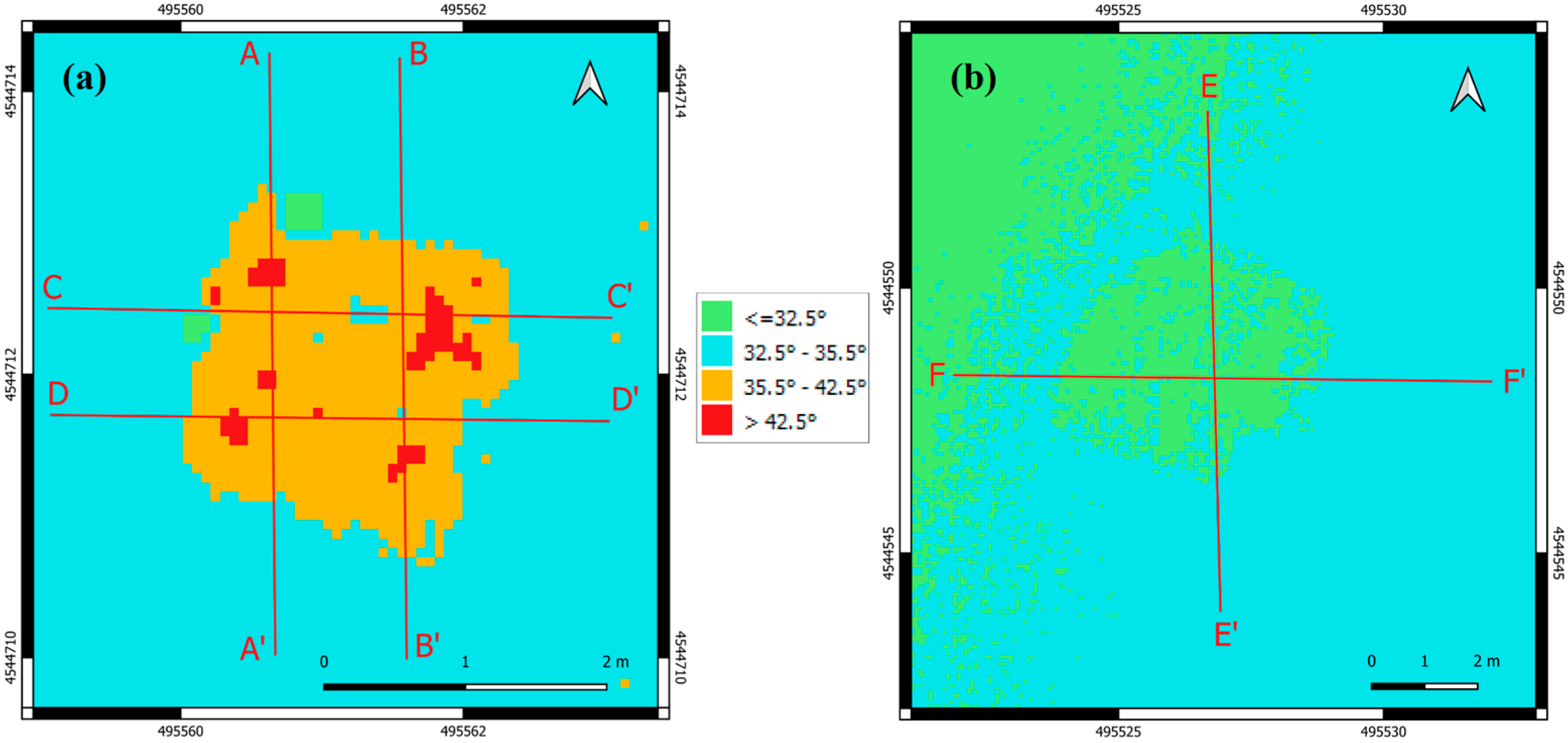


| UAV Platform | Sensor Type | Specifications | Spectral Range/Bands | GSD 15 m AGL | Main Application |
|---|---|---|---|---|---|
| DJI Mavic 3 Enterprise | RGB camera | 20 MP, 4/3 CMOS, 24 mm EFL, 84° FOV | Visible (Red, Green, Blue) | ~1.5 cm/pixel | High-resolution mapping, reference basemap |
| DJI Mavic 3 Multispectral | Multispectral | 4 × 5 MP sensors (25 mm EFL, 73.91° FOV) + 20 MP RGB | Green (560 ± 16 nm), Red (650 ± 16 nm), Red Edge (730 ± 16 nm), NIR (860 ± 26 nm) | ~5 cm/pixel | Spectral discrimination, index computation |
| DJI Mavic 3 Thermal | Thermal infrared | 640 × 512 px LWIR microbolometer, 40 mm EFL, 61° FOV | 8–14 µm (LWIR) | ~6 cm/pixel | Thermal contrast detection, material variability |
| Parameter | Value/ Description |
|---|---|
| Flight date | 31 July 2024 |
| Location | Lake Calore (Mirabella Eclano, Avellino, Italy) |
| Flight planning software | UgCS Enterprise version 4.16 |
| Flight altitude | 15 m AGL |
| Image overlap | 80% (front and side) |
| Flight path | Double parallel grid with evenly spaced waypoints |
| Time of acquisition | ~11:00 UTC (ascending solar heating phase) |
| Meteorological conditions | Clear sky, wind speed < 2 m/s, no precipitation |
| Positioning accuracy | RTK GNSS (INGV RING station GRO1, Grottaminarda) |
| Acquisition mode | Automated mission with synchronized camera triggering |
| BANDS | Water | Natural Target | Plastic Target | |||
|---|---|---|---|---|---|---|
| μ ± σ | CV% | μ ± σ | CV% | μ ± σ | CV% | |
| GREEN | 0.10 ± 0.02 | 21.05 | 0.30 ± 0.07 | 23.26 | 0.42 ± 0.14 | 31.89 |
| RED | 0.06 ± 0.01 | 26.31 | 0.19 ± 0.05 | 28.48 | 0.34 ± 0.16 | 47.81 |
| RED-EDGE | 0.03 ± 0.01 | 40.16 | 0.19 ± 0.02 | 12.51 | 0.14 ± 0.02 | 11.80 |
| NIR | 0.02 ± 0.01 | 48.99 | 0.12 ± 0.01 | 12.21 | 0.07 ± 0.00 | 5.59 |
| Index | Water | Natural Target | Plastic Target |
|---|---|---|---|
| PDI | <0.36 | 0.38–0.42 | 0.40–0.50 |
| HPI | <0.10 | 0.15–0.25 | 0.30–0.80 |
| INDEX | Overall Accuracy | Kappa | F1-Score Plastic | F1-Score Vegetation | F1-Score Water |
|---|---|---|---|---|---|
| PDI | 0.89 | 0.83 | 0.90 | 0.84 | 0.92 |
| HPI | 0.86 | 0.78 | 0.87 | 0.88 | 0.85 |
| PDI-HPI combination | 0.92 | 0.86 | 0.91 | 0.90 | 0.94 |
Disclaimer/Publisher’s Note: The statements, opinions and data contained in all publications are solely those of the individual author(s) and contributor(s) and not of MDPI and/or the editor(s). MDPI and/or the editor(s) disclaim responsibility for any injury to people or property resulting from any ideas, methods, instructions or products referred to in the content. |
© 2025 by the authors. Licensee MDPI, Basel, Switzerland. This article is an open access article distributed under the terms and conditions of the Creative Commons Attribution (CC BY) license (https://creativecommons.org/licenses/by/4.0/).
Share and Cite
Famiglietti, N.A.; Verlanti, A.; Di Renzo, L.; Nunziata, F.; Memmolo, A.; Migliazza, R.; Buono, A.; Migliaccio, M.; Vicari, A. UAV Multisensor Observation of Floating Plastic Debris: Experimental Results from Lake Calore. Drones 2025, 9, 799. https://doi.org/10.3390/drones9110799
Famiglietti NA, Verlanti A, Di Renzo L, Nunziata F, Memmolo A, Migliazza R, Buono A, Migliaccio M, Vicari A. UAV Multisensor Observation of Floating Plastic Debris: Experimental Results from Lake Calore. Drones. 2025; 9(11):799. https://doi.org/10.3390/drones9110799
Chicago/Turabian StyleFamiglietti, Nicola Angelo, Anna Verlanti, Ludovica Di Renzo, Ferdinando Nunziata, Antonino Memmolo, Robert Migliazza, Andrea Buono, Maurizio Migliaccio, and Annamaria Vicari. 2025. "UAV Multisensor Observation of Floating Plastic Debris: Experimental Results from Lake Calore" Drones 9, no. 11: 799. https://doi.org/10.3390/drones9110799
APA StyleFamiglietti, N. A., Verlanti, A., Di Renzo, L., Nunziata, F., Memmolo, A., Migliazza, R., Buono, A., Migliaccio, M., & Vicari, A. (2025). UAV Multisensor Observation of Floating Plastic Debris: Experimental Results from Lake Calore. Drones, 9(11), 799. https://doi.org/10.3390/drones9110799












